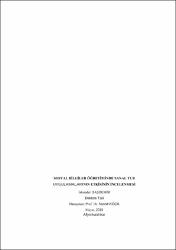Sosyal Bilgiler Öğretiminde Sanal Tur Uygulamalarının Etkisinin İncelenmesi
Özet
Bu araştırmanın genel amacı, Sosyal bilgiler öğretiminde sanal tur etkinlikleri kullanımının öğrencilerin akademik başarısına, Sosyal bilgiler dersine karşı motivasyonlarına ve tutumlarına etkisini incelemektir. Bunun yanı sıra Sosyal bilgiler dersinde sanal tur etkinlikleri kullanımına ilişkin öğrencilerin görüşlerinin incelenmesi de amaç edinilmiştir. Araştırmada karma yöntem desenlerinden açımlayıcı sıralı desen kullanılmıştır.
Araştırma için gerekli olan verilerin toplanması için araştırmacı tarafından geliştirilen “Türk Tarihinde Yolculuk Ünitesi Başarı Testi”, Kan (2012) tarafından geliştirilen “Sosyal Bilgiler Dersi Motivasyon Ölçeği”, Demir ve Akengin (2010) tarafından geliştirilen “Sosyal Bilgiler Dersi Tutum Ölçeği” kullanılmıştır. Sosyal bilgiler dersinde sanal tur etkinlikleri kullanımına yönelik öğrencilerin görüşlerinin belirlenmesi amacıyla araştırmacı tarafından geliştirilen yarı yapılandırılmış odak grup görüşme formu kullanılmıştır. Veri toplama süreci sonunda elde edilen veriler dijital ortamda analiz edilmiştir. Normal dağılım sergileyen nicel veriler üzerinde parametrik testler uygulanmıştır. Elde edilen nitel veriler üzerinde ise içerik analizi yapılmıştır.
Araştırmanın sonucunda Sosyal bilgiler dersinde sanal tur etkinlikleri kullanımının, öğrencilerin akademik başarısı, Sosyal bilgiler dersine yönelik motivasyon ve tutumları üzerindeki etkisine bakıldığında deney ve kontrol grubu öğrencilerinin deneysel süreç öncesinde akademik başarılarında, Sosyal bilgiler dersine karşı motivasyon ve tutumlarında anlamlı bir farklılık yok iken; deneysel süreç sonunda deney grubu lehine anlamlı farklılık olduğu belirlenmiştir. Araştırmanın nitel sonuçları incelendiğinde Sosyal bilgiler dersinde sanal tur etkinliklerinin kullanımının öğrencilere bireysel ve derslere yönelik çok sayıda katkılarının olduğu belirlenmiştir. Nitel sonuçlar bağlamında Sosyal bilgiler dersinde sanal tur etkinliklerinin kullanımında karşılaşılan sorunlar boyutunda internet ve alt yapı problemleri, sanal tur etkinliklerinin kullanımının çok zaman alması, teknolojik araçların kullanımında yeterliliğe sahip olmayan öğrencilerin derste sıkıntılar yaşaması, gibi durumların ifade edildiği görülmüştür. The general objective of this study is to investigate the effects of usage of virtual tour activities in Social Science education on academic success, motivation and attitude toward Social Science lecture of students. Beside it is aimed to investigate the views of students regarding to usage of virtual tours in Social Science lectures.
To obtain the data necessary of this study, the unit of the journey to Turkish history achievement test developed by the researcher, ‘Social Science lecture motivation scale’ developed by Kan (2012), ‘Social Science lecture attitude scale’ developed by Demir and Akengin (2010) have been used. In order to determine the views of students on the usage of virtual tours in Social Science lecture, semi structured focus group interview form developed by the researcher has been used. After gathering necessary data, they have been analyzed via pocket software. Parametric tests have been used for the data showing normal distribution. The content analysis has been performed for the qualitative data.
When analyzed the effects of usage of virtual tours in Social Science lecture on academic success, motivation and attitude of students, results show that before experimental process there has been not any significant difference between experiment and control group students. However, at the end of the experimental process there has been a significant difference in favor of experiment group of students. Qualitative results indicate that the usage of virtual tours in Social Science lecture have many benefits and contribution to both each individual and attitudes toward the lecture. The results of qualitative analysis also demonstrates that there has been some problems to apply virtual tours such as internet and infrastructure problems, extended period of time for using virtual tours and problems regarding to students who are not capable of using technological devices.



















